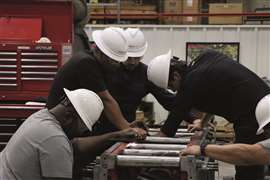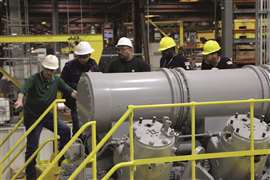Training a new generation
October 03, 2024
Guidelines for success by Jason Edwards, director of Training at Cooper Machinery Services
 Generation Z employees will surpass the older Generation X in the oil & gas industry within the next 10-15 years.
Generation Z employees will surpass the older Generation X in the oil & gas industry within the next 10-15 years.
Technical expertise is the catalyst of operational efficiency and productivity in any industry. Ensuring that your workforce is not only skilled but also operates with the highest level of safety and proficiency is crucial for competitiveness and longevity. Without a capable workforce, the ability to meet business goals becomes doubtful at best. While this challenge is not new, it remains a top priority in our industry. The fate of the workforce was a concern 60 years ago; it is a concern today, and it will remain a concern 60 years from now. While the underlying need has not changed, the challenge of how to address it is changing drastically.
Generation Z and their relationship to technical training is a concern for the oil and gas industry for good reason. This employee population will surpass Generation X as the majority of the industry’s workforce within the next 10-15 years. The reality is simple. Those in the industry who are retiring contain a high percentage of practical knowledge. This knowledge, developed over many years of experience, is now departing. The workforce needs to be replaced, and there is concern that the current or past practices of knowledge transfer may not be effective to address the learning needs of the next generation.
Workforce model
Many companies have traditionally relied on a workforce model of knowledge transfer, where new employees are assigned to work alongside a highly experienced employee. The goal is for the highly skilled employee to pass on their knowledge to the new employee over time, eventually creating another skilled employee. This model is based on several significant assumptions. It assumes that the highly skilled employee is indeed training the new employee, that the new employee is learning valuable skills, and that the tasks assigned to the new employee are meaningful and not just lesser-value work. It is also assumed that the new employee is capable of learning the content, that the skilled employee can effectively train someone, and that the company is actually saving money and resources with this approach.
Historically, the workforce model was effective because the number of experienced employees outnumbered those with little to no experience. This allowed the experienced employees to maintain work quality while mentoring the less experienced employees. However, as more experienced employees retired, this balance shifted. For instance, 30 years ago, a crew might have consisted of four highly skilled employees and one less experienced employee. Today, you might find one highly skilled employee working with three less experienced employees at various levels. With this change in ratio and the unique learning approaches of Generation Z, the traditional workforce model no longer suffices. A new training model is required, though it is not entirely new. Elements of this model have been effective for years but now need to incorporate the distinct learning needs of Generation Z to remain effective.
Immersed in technology
Generation Z is the first generation to be fully immersed in technology, particularly proficient in social media and visual technology. Having grown up with screens in hand for most of their lives, Generation Z employees are very comfortable using technology. This generation, like those before them, has individuals who are highly intelligent and motivated, as well as those who are less motivated. The main observable differences are:
■ Technologically savvy: They are adept at using technology but are not necessarily technologically skilled in the development and/or programming of this technology.
■ Learning style: They excel at learning in small, digestible segments, often using online resources.
■ Communication: They are proficient in technology, such as texting or social media.
■ Entertainment: They prefer entertainment through technology, like streaming services or gaming.
■ Learning preference: They enjoy incorporating technology into their learning process.
■ Video utilization: They use video as a tool for learning and memory reinforcement.
■ Visual learning: Their learning approach is heavily influenced by visuals due to their exposure to video content.
■ Feedback: They are accustomed to regular and immediate feedback, which they often seek in their learning experiences.
 Generation Z employees will surpass the older Generation X in the oil & gas industry within the next 10-15 years.
Generation Z employees will surpass the older Generation X in the oil & gas industry within the next 10-15 years.
Holistic approach
To effectively train Generation Z, a holistic approach is required, involving design learning events that build upon each other to achieve specific performance outcomes. The following guidelines can help create a program tailored to the needs of both the employees and the business.
■ Analysis: Understand the specific learning needs and preferences of Generation Z employees.
■ Performance-based learning outcomes: Define clear, measurable outcomes that align with job performance.
■ Content design: Create engaging and interactive content that is relevant and relatable to Generation Z.
■ Use of video: Incorporate video as a primary learning tool, leveraging their preference for visual content.
■ Learning transitions into the work area: Ensure smooth integration of learning into the work environment to facilitate the application of new skills.
■ Team structures to support learning: Foster a collaborative learning environment with team-based activities and projects.
■ Learning reinforcement: Provide regular feedback and opportunities for practice to reinforce learning.
■ Sequence of learning: Organize learning events in a logical sequence that builds upon previous knowledge and skills.
■ Targeted use of assessments: Use assessments to gauge understanding and tailor learning experiences accordingly.
■ Using practical learning methods: Incorporate hands-on, experiential learning opportunities to enhance understanding and retention.
■ Training the trainers and supervisors: Equip trainers and supervisors with the skills and knowledge to effectively support and mentor Generation Z employees.
■ Ongoing evaluation of learning: Continuously evaluate the effectiveness of the training program and adjust as needed to ensure relevance and impact.
Technical training has evolved, and the traditional workforce model is no longer as effective as it once was. To remain competitive, businesses must develop comprehensive training programs that cater to the needs of the next generation of learners. By investing in talent development, businesses can adjust to evolving needs more effectively and prepare employees for advancement within the organization. In summary, a quality training program aims to build talent, strengthen the bench, and ultimately grow the business. Following these guidelines will support this developmental process effectively.
MAGAZINE
NEWSLETTER

CONNECT WITH THE TEAM









